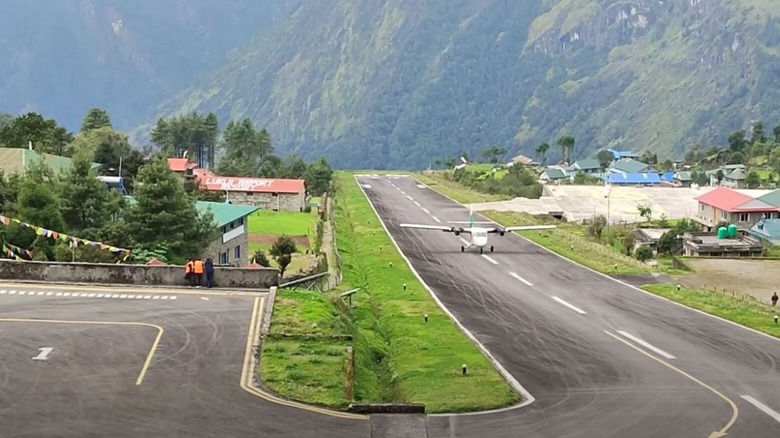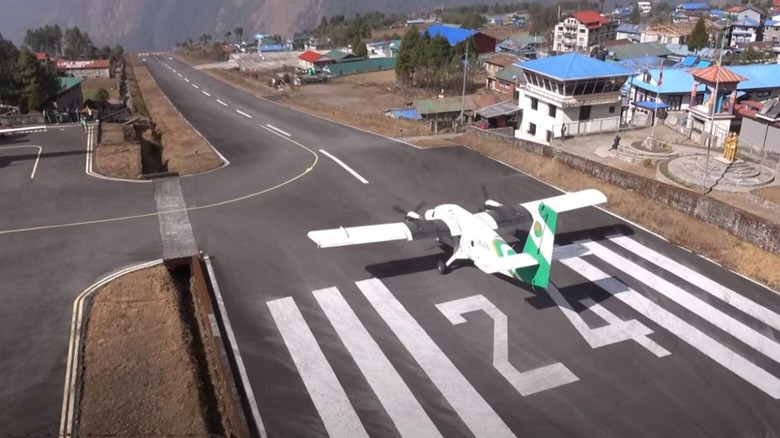What's The Most Difficult Airport For Landing A Plane? Here's What Pilots Say
As a point of entry and exit for a country, airports serve a vital function for passengers and travelers. Alongside people, airports also facilitate the movement of international cargo, which includes raw materials, supplies, machinery, and even finished goods. As of 2025, there are more than 40,000 airports worldwide that vary in size, from some of the longest airport runways in the world, with runways over 15,000 feet, to a tiny tarmac just 1,312 feet in length. Airports can be found in diverse locations, such as cities, deserts, and even on bodies of water, which can be a challenge for pilots, but the most difficult airport to land on can be found in Nepal, and it's called Lukla Airport.
In 1964, renowned explorer and mountaineer Sir Edmund Hillary began work on an airport aimed at improving supply logistics and access to the area. Starting with locating and purchasing property, Hillary then allegedly mobilized the local sherpas to help compress the ground by performing traditional foot stomp dances before construction could begin. Since starting its operations in 1971, Lukla was more of an airstrip with a dirt runway. Its tarmac was finally paved in 2001.Alongside its service to the Nepalese community, Lukla airport also serves as the most direct and quickest access point to go to Mount Everest.
The geography and climate of Lukla's location are the primary reasons why it is considered by pilots as the most dangerous airport to land on. Nestled at nearly 9,400 feet above sea level, its thinner air makes it harder for aircraft to work properly. Its altitude also causes unpredictable weather conditions, which can affect visibility and wind speed. LTo make matters worse, the airport is encircled by steep mountains, with a ridge and a very deep gorge on each side.
Perilous airfield at the roof of the world
Alongside the environmental features of the area, the spartan facilities of Lukla airport contribute to its difficulty. Starting with its very short 1,800-foot-long runway, it gives scarce leeway for mistakes – a plane can fall off the opposite side if it overshoots. This is aggravated because the airport doesn't have important equipment, including radar and instrument landing systems, to help the pilots. Finally, because aircraft can only land in one direction, there is no missed approach protocol for Lukla airport, meaning the aircraft must push through with the landing.
Due to the demanding conditions at Lukla Airport, there have been several accidents throughout the years,which resulted in injuries and fatalities to passengers and crew. Despite this, the airport still serves a substantial number of passengers annually, averaging around 45,000.With its limited space, Lukla airport can only accommodate small aircraft capable of short takeoff and landing, together with rotor aircraft.To address the growing passenger volume and provide better services, safety enhancements to Lukla airport are being made, including installing an X-ray scanner, which, though an improvement, is miniscule compared to the equipment installed in the most upscale airports in the world.
To commemorate their historic achievement of being the first to summit Mount Everest, Lukla airport was renamed as the Tenzing-Hillary airport in 2008, shortly after the death of Sir Edmund Hillary.By enabling a faster and more efficient route to Mount Everest, Lukla airport supports the economy of Nepal through more tourism. Alongside its commercial benefit, the airport is also a critical hub for disaster and emergency response for locals and mountaineers alike. Interestingly, while Lukla is perilous due to its high elevation, another airport in Japan is the opposite because it is gradually sinking.

